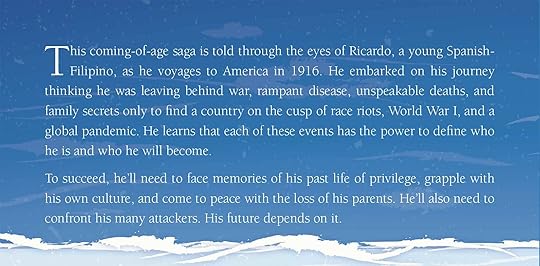Jennifer Hallock's Blog: Sugar Sun Series Extras, page 2
August 30, 2021
The Grand Reopening of Hotel Oriente

I am excited to announce that the Hotel Oriente is open after a pretty thorough remodel: better pacing, more hotel tidbits, and—best of all—brunch!
 From the author’s note of the revised edition.
From the author’s note of the revised edition.BUT WAIT! If you have not read Hotel Oriente yet, I have an amazing deal for you. You can grab it and nine more books in the Romancing the Past anthology for almost nothing. Yes, all ten swoony romances for the low price of 99¢ until September 15th, and only $3.99 after that.
 Grab all ten swoony romances, including the rerelease of Hotel Oriente, in one amazing anthology.
Romancing the Past
is available at all major retailers.More from the Author’s Note of the 2021 Revision of
Hotel Oriente
:
Grab all ten swoony romances, including the rerelease of Hotel Oriente, in one amazing anthology.
Romancing the Past
is available at all major retailers.More from the Author’s Note of the 2021 Revision of
Hotel Oriente
:Let’s dig into the history. Yes, the Hotel de Oriente did exist, though it was known by many spellings. Hotel de Oriente was the name plastered across the exterior molding, but I found all the following used: Hotel Oriente, Hotel d’Oriente, Hotel el Oriente, Hotel Orient, and every one of these in reverse order. It was the place to stay until the Insular Government purchased it in November 1903 to use as the headquarters of the Philippine Constabulary.
 Learn about the troubled, faded glory Hotel Oriente in the center of Manila, the Pearl of the Orient.
Learn about the troubled, faded glory Hotel Oriente in the center of Manila, the Pearl of the Orient.Many photos exist of the exterior of the building, and Las Casas Filipinas de Acuzar has even built a working reconstruction and conference center in Bataan, which I have visited. Other than a few room photos, though, the interior is known only from traveler’s reports, including those on Lou Gopal’s Manila Nostalgia blog, as well as a variety of journals in the public domain. From these, I borrowed the complaints over “missing” mattresses and excessive egg dishes. I borrowed the bathtub incident from my father-in-law, who managed an American military hotel in Bangkok during the late 1960s.
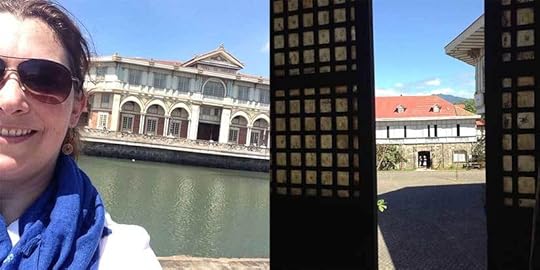 Left: The Hotel de Oriente and me! Right: The view out our hotel window to the heritage bahay na bato across the square. Parts of Heneral Luna were filmed here at Las Casas Filipinas de Acuzar.
Left: The Hotel de Oriente and me! Right: The view out our hotel window to the heritage bahay na bato across the square. Parts of Heneral Luna were filmed here at Las Casas Filipinas de Acuzar.A real assistant manager of the Oriente was implicated in the true scandal that almost engulfed Moss and Seb. Captain Frederick J. Barrows, the actual quartermaster of Southern Luzon, stole one hundred grand a month for almost a full year, pocketing nearly $1.2 million by 1901 (the equivalent of $38 million in 2020). This was nowhere near the largest war profiteering in world history—that honor goes to reconstruction contracts during the Iraq War—but it is still a lot of money. A court-martial sentenced Barrows to five years in Bilibid Prison, and that may have been getting off easy. He had a better chance at a fair trial inside the military than out of it. This was true for all civilians, Filipino or American. The Insular Cases, a series of 1901 decisions by the U.S. Supreme Court, were the true legal architecture of empire, and they said that the Constitution did not follow the flag. I pushed forward the date of these decisions for my story, but only by a few months.
 Contemporary accounts of the quartermaster scandal in Manila, along with the destination of the guilty: Bilibid Prison.
Contemporary accounts of the quartermaster scandal in Manila, along with the destination of the guilty: Bilibid Prison.Much of Della’s article on the scandal is reproduced from the Los Angeles Herald’s April 1st issue, no joke. Please consider this acknowledgment my endnote for “Far Reaching Frauds in Army Commissary,” from page one. I used as much of the original wording as I could because I wanted Della’s writing to match the standards of the profession in 1901. The previous edition of this novella did not do a good job of displaying her talents as a journalist.
 An advertisement from the 1901 Commercial Directory of Manila and a close up of an 1898 map of Manila and suburbs.
An advertisement from the 1901 Commercial Directory of Manila and a close up of an 1898 map of Manila and suburbs.Della’s story was inspired by a deaf voyager, memoirist, and teacher named Annabelle Kent. While I was researching Under the Sugar Sun, I found a terrific description of a steamer’s rough entrance into Manila Bay. Kent’s Round the World in Silence proved her to be a thrill-seeking woman impervious to seasickness. (According to later U.S. Navy experiments, those with a damaged vestibular system are less likely to suffer from the bucking motion of the waves.) She circumnavigated the globe, mostly with strangers who did not speak American Sign Language. To me, Kent had the perfect spirit to infuse a romance heroine.
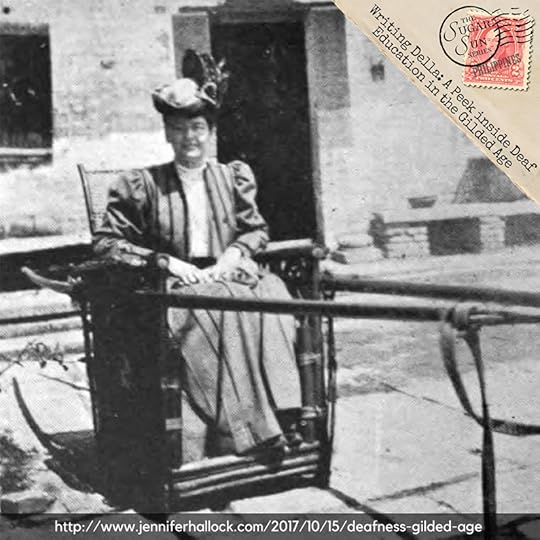 Take a peek inside deaf education in the Gilded Age with heroine Della Berget, modeled on real-life adventuress, Annabelle Kent. Find out more.
Take a peek inside deaf education in the Gilded Age with heroine Della Berget, modeled on real-life adventuress, Annabelle Kent. Find out more.People say to “write what you know,” which is excellent advice—but plot bunnies lead me down precarious burrows. Could a deaf writer have better written about Della Berget? No doubt. Are there better books out there about Deaf Culture? Every single one written by someone who identifies as hard of hearing to profoundly Deaf. But I took a risk and wrote Della as best I could. This meant research: the Limping Chicken blog and the Gallaudet University archives were especially helpful. Of course, all mistakes or errors are entirely mine. At the time, the U.S. Congress required Gallaudet to teach only the “Oral Method” of communication, which is why she speechreads instead of speaking ASL. Della does not yet know other deaf people in her corner of Manila—she is new to the city—so there is not enough treatment of Deaf Culture and its rewards in this story, nor would I be the best person to translate such ideas to the page.
 Two photos of the “sleeping machine” at the Hotel de Oriente from the Burton Holmes Travelogue.
Two photos of the “sleeping machine” at the Hotel de Oriente from the Burton Holmes Travelogue.Moss is also loosely based on an actual person: West G. Smith, the American manager who ran the hotel for Ah Gong, proprietor. West Smith became Moss North? His wife Stella became Della? Yes, I amuse myself. Smith arrived with the Thirteenth Minnesota Volunteers and stayed to manage the Oriente, but the rest of Moss’s personal history was entirely fiction. Also, I liked the name and story behind the White Elephant resort in Nantucket, but it has no relation to Moss’s uncle’s hotel, which was instead based on the Windsor in St. Paul.
Hughes Holt’s background was a fictionalized conflation of the two West Virginian congressmen of the era, but his personality hews closer to Senator Albert J. Beveridge of Indiana, an orator who built a career on the embrace of overseas expansion. Beveridge did visit the Philippines—albeit two years earlier, in May of 1899—so that he could “understand the situation” (his words) before assuming his seat in the Senate. Unlike Holt, Beveridge impressed local soldiers with his physical endurance and ability to withstand deprivation. Like Holt, he left the islands more imperialist than ever. Emboldened, the U.S. Army would wage a relentless war, and so would privateers. The anecdote about violent American outlaws in Pampanga was ripped from page six of the 15 May 1901 issue of the New York Times.
 Menu excerpts from the Hotel Oriente, 1900-1902. The top three are each relevant to a different scene from either
Hotel Oriente
or
Under the Sugar Sun
. IF YOU’VE READ THIS FAR, HERE IS YOUR REWARD: Be the first to identify at least one of these scenes and I will gift you an e-copy of my upcoming novella—on Rosa’s redemption—once it is released. Enter by commenting on this post below.
Menu excerpts from the Hotel Oriente, 1900-1902. The top three are each relevant to a different scene from either
Hotel Oriente
or
Under the Sugar Sun
. IF YOU’VE READ THIS FAR, HERE IS YOUR REWARD: Be the first to identify at least one of these scenes and I will gift you an e-copy of my upcoming novella—on Rosa’s redemption—once it is released. Enter by commenting on this post below.Though Moss’s anti-imperialist attitudes were rare among soldiers, his concerns can be found in archived letters, newspapers, and Senate testimony. It was Major General Smedley Butler, USMC—two-time recipient of the Medal of Honor and veteran of the Philippine-American War—who wrote War is a Racket in 1935. He claimed that his three-plus decades of service had been “conducted for the benefit of the very few [commercial and oil interests], at the expense of the very many.”
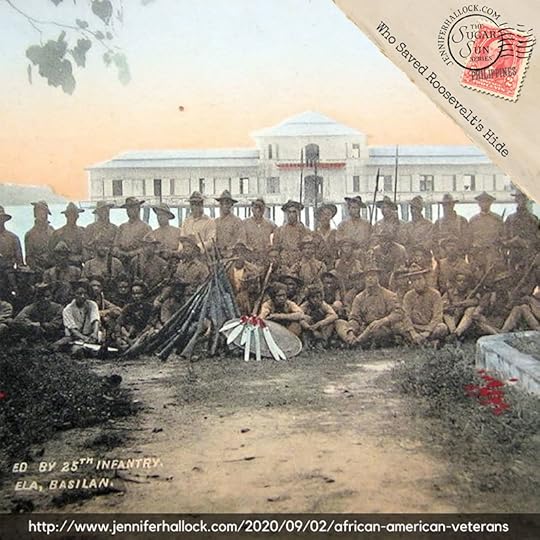 How much of Roosevelt’s reputation was fake news? And who had really saved his hide in Cuba? Read more about African American heroes of the Spanish-American War.
How much of Roosevelt’s reputation was fake news? And who had really saved his hide in Cuba? Read more about African American heroes of the Spanish-American War.It did not take as long for others to see the light. Soldiers of African American regiments related the injustice of imperialism with contemporary clarity. Sergeant Major John W. Calloway of the Twenty-Fifth Infantry was persecuted views he expressed only in private correspondence. Calloway was especially close to Filipino physician Torderica Santos, much like Moss was best friends with the fictional Judge Eusebio Lopa (inspired by the real Lieutenant Salvador G. Lara). Calloway also made his life in the Philippines after the war, marrying and raising fourteen children.
 Read more about why cocaine for surgery and heroin from the Sears Catalog was actually a step up for the history of medicine.
Read more about why cocaine for surgery and heroin from the Sears Catalog was actually a step up for the history of medicine.That brings me to Moss’s use of a condom, which was based on the state of contraception at the turn of the twentieth century. I do not know how hard it would have been to purchase a sheath in Manila, but it may have been easier there than in the United States. The 1873 Comstock Act had made it illegal to distribute birth control or information about birth control through the mail or across state lines, not imperial ones. Yes, the Philippines was a majority Catholic country, but papal pronouncements did not ban “artificial contraception” until 1930. Did Della understand what the condom was? It was possible, given the close contact she had with married friends at her university. Also, hearing people tended to be indiscreet around her, often to their own detriment.
Thanks for getting this far. Remember that your honest review helps readers find books they love. If you have taken the time to rate and review on Goodreads or the retailer of your choice, thank you. For everyone, I hope you enjoyed Moss and Della’s story. Here’s wishing you a History Ever After!

August 24, 2021
Psst…Update your Hotel Oriente
I have some fun news coming soon, and I do not wish to spoil it. I will say this: if you have purchased Hotel Oriente in the past, please go update your copy now. Go to “Manage Content and Devices,” search “Hotel Oriente,” and click “update.” Yay! More to come, including an explanation, I promise…
August 1, 2021
Brave Crossing: Interview with Maria Alvarez Stroud
Brave Crossing: A Journey In-Between is a powerful epistolary immigrant story set during a turbulent and harrowing period of virulence, violence, and racism in the United States. It was also a wonderfully human story in which the main character Ricardo was challenged, blundered, and was redeemed—and that was what kept me reading far too late into the night.
I met the author, Maria Alvarez Stroud, at the 2021 Historical Novel Society conference, and she agreed to answer a few questions for readers of this blog. Thank you, Maria!

MAS: Ahhh, I love this question. More than digging deep into the research of all of the major catastrophes, both in the Philippines and in the United States, I labored over what was going on within the heart and soul of the main character. More than anything, I wanted his journey to mirror what I believed my father went through.
The recognized historian of our Filipino clan helped immensely as he had known my father as a young boy. Visiting his hometown, Santa Cruz, as well as all the neighborhoods where he lived here in the United States was beneficial. I took long walks to literally imagine what it was like to walk in his shoes. Sometimes I’d find myself lost, far away from any planned destination. I talked with siblings, especially my brother who always said he was too much like our father. With every scene I tried to imagine what he felt, being alone in a foreign country, struggling to find his way, when so many obstacles stood before him. I won’t say it was easy, but I did the best I could to capture his internal journey.
JH: In a related question, how much did your father talk with you or anyone in your family about his early years in Chicago and the racial discrimination he faced?MAS: He didn’t talk about those years hardly at all, which is why I had such a desire to discover what life in the early 1900s was like for a Filipino coming to America, especially to a city of 2 million+ with fewer than 300 Filipinos. There were bits and pieces he mentioned: like flunking English several times, and being assigned the only other non-white student as a lab partner. Knowing the circumstances he was living under, I relied on research and read any account I could get my hands on about what non-whites experienced, from Angel Island to the general public dance halls.
 The real Ricardo’s 1924 yearbook photo (p. 34), courtesy of the Hilltop at Marquette University ArchivesJH: Was there a real José (Ricardo’s friend who enlists to fight in the Great War)?
The real Ricardo’s 1924 yearbook photo (p. 34), courtesy of the Hilltop at Marquette University ArchivesJH: Was there a real José (Ricardo’s friend who enlists to fight in the Great War)?MAS: No, José was a fictional character based on research. There was one other Filipino attending the University of Chicago at the time Ricardo went, and there were Filipinos who fought in World War I. Knowing the University wasn’t that large at that time, it was highly likely they would have met and become friends. I took the liberty to have his future play out the way it did, to emphasize the sense of aloneness the character must have experienced and the plight of veterans of WWI.
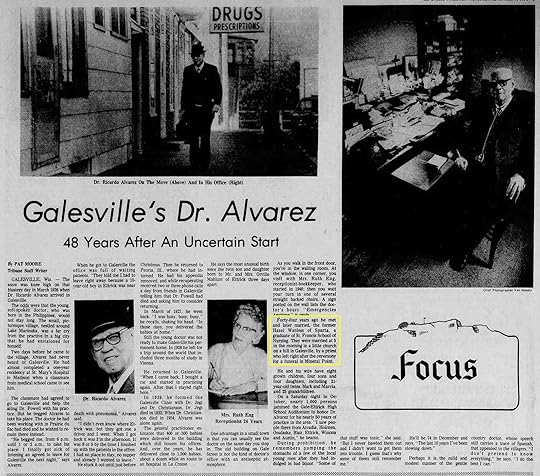 “Galesville’s Dr. Alvarez” from the 7 November 1974 issue of the La Crosse (Wis.) Tribune, page 9.JH: Readers of my books will want to know lots more about Hazel. Anything you can share? (I did dig up an article, above, that described the scene: “They were married at 5 in the morning in a little church on a hill in Galesville, by a priest who left right after the ceremony for a funeral in Mineral Point.” Tell us more!)
“Galesville’s Dr. Alvarez” from the 7 November 1974 issue of the La Crosse (Wis.) Tribune, page 9.JH: Readers of my books will want to know lots more about Hazel. Anything you can share? (I did dig up an article, above, that described the scene: “They were married at 5 in the morning in a little church on a hill in Galesville, by a priest who left right after the ceremony for a funeral in Mineral Point.” Tell us more!)MAS: From what I have heard from many of my siblings, as well as from my mother, it was love at first sight. Hazel was a second-generation Norwegian who grew up on a farm an hour away from the nursing school she attended and the hospital where she met Ricardo. Once she told me her favorite pet growing up was a baby lamb that she raised to an adult. My guess is that she had seen few darker-skinned people before she met Ricardo. Moreover, she was raised Protestant, and he a devoted Catholic.
JH: What has been the best part of writing Ricardo’s story?MAS: Getting to know my father, the man behind the title, has been the best part. I wouldn’t have been able to even say this without doing all the research about his life growing up, the circumstances of his childhood, and what life was like as an immigrant in this country. It is an immigrant story after all, and a story of hope that is much needed today.
Thank you, Maria, and congratulations on your new release! Readers, Brave Crossing is on sale now so pick up your copy today.Content guidance: includes depictions of racism, colorism, and classism; suicide (off-page); infant mortality; death of mother; death of father; combat trauma; and epidemic disease. No significant sexual content.
June 28, 2021
Nonfiction Recommendations from the Hallock Classroom

I am lucky. I get to teach important stuff that few survey classes touch. By the time US history teachers get to the Spanish-American War, they have one eye on the Great War and everything it sets in motion, and the other eye on the AP test coming up likely in a matter of weeks. Most students I talk to bemoan the fact that they barely cover Vietnam, and their teachers are likely a lot more familiar with Vietnam than the Philippine-American War. If they cannot cover My Lai, Woodstock, and Agent Orange, how can they find time for Balangiga, the Lodge Commission, and the water cure? (Well, some students do, and in the eighth and ninth grade no less!)
I teach trimester electives to mostly high school seniors about American empire and war in the Philippines (and China, Hawaii, Japan, and Pacific islands), in Vietnam (and Cambodia and Laos), and in Iraq (along with Iran, Afghanistan, and more). I try to add value with my own synthesis and analysis, but simply assigning the right readings is the first step to knowledge. I thought I might share some recommendations, not all of which are pictured above. Note that I make no money off the sales of these books, nor have I received any free copies or compensation for endorsing them. This is a 100% “word of mouth” genuine recommendation!
 Park with gazebos and benches in Manila, Philippines (1901). To the right is the Luneta Beach. The Ermita Beach went on south behind the tree. Roxas Blvd. of today goes along where the water line and beach is in this picture. Luneta Park area was filled in where the Manila Hotel, Elks Club, Army & Navy Club, and US Embassy are today. Original at the Library of Congress, provided by John Tewell.How to hide an empire
Park with gazebos and benches in Manila, Philippines (1901). To the right is the Luneta Beach. The Ermita Beach went on south behind the tree. Roxas Blvd. of today goes along where the water line and beach is in this picture. Luneta Park area was filled in where the Manila Hotel, Elks Club, Army & Navy Club, and US Embassy are today. Original at the Library of Congress, provided by John Tewell.How to hide an empireThis book by Daniel Immerwahr is, in his own words, not really new information—but considering how deftly he weaves together the many threads, you might think it is. How to Hide an Empire is a sweeping history of US expansion since independence, when what we call a republic was actually as much undefined territory as it was incorporated state. It’s eye-opening in a red-pill Matrix way, yet it manages to be entertaining and even funny. How did American Pacific empire between with bird shit? True story. How did overseas US bases inspire the Beatles and Sony? And what does the base system look like now, and why don’t Americans hear about it more in the news?
I would recommend this book to everyone from young adults on up, but I think it is especially important for US citizens. Though I use it as “homework,” it does not feel like it to my students. Many of them choose to read the portions we have not assigned in class because it is that good.
 The Malecon Drive ran parallel to the Manila Bay, opening at its southern end to the Luneta, early twentieth century. Photo courtesy of the White House Historical Association.overthrow
The Malecon Drive ran parallel to the Manila Bay, opening at its southern end to the Luneta, early twentieth century. Photo courtesy of the White House Historical Association.overthrowWhile How to Hide an Empire paints the forest vividly, with the occasional tree, Overthrow by Stephen Kinzer is a neat row of evergreens at a Christmas tree farm. And just like that row planted by some agri-corp eager to make a profit off idealistic, family-farm nostalgia, Kinzer lays out difficult truths of big business behind seemingly altruistic goals. Each chapter takes the reader through the spy-thriller-esque story (but darker) of every time the US has overthrown a foreign government.
Sometimes the role was at least in part unofficial—a cabal of American-born landowners overthrew the queen of Hawaii, but they probably would not have succeeded had the US envoy not landed the Marines on shore in support. But sometimes the role was very much official, such as when the CIA overthrew the popularly-elected prime minister of Iran in 1953. Kinzer has individual titles that dig more deeply into individual cases, such as his books on the debate over the seizure of the Philippines, the coups in Iran and Guatemala, and the unbelievable Cold War origins when the leaders of US covert and overt foreign policy were brothers! And that’s just the tip of the iceberg.
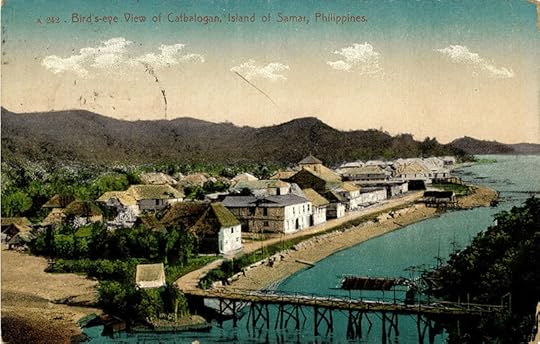 Vintage postcard of Samar with a view of the wooden causeway connecting town to the port. Scanned image of the early 20th century card by Leo D. Cloma.The 9/11 report: a Graphic Adaptation
Vintage postcard of Samar with a view of the wooden causeway connecting town to the port. Scanned image of the early 20th century card by Leo D. Cloma.The 9/11 report: a Graphic AdaptationThe authors of the first published 9/11 Report intended to make the text readable because they wanted to reach the widest range of Americans possible, to answer the “Why?” questions better than the television networks were doing. But it was a big book, with, you know, lots of words. In my class I use this visual adaptation, and it is often the first time that my students have a teacher using a graphic novel as an instructional tool. They find that disconcerting because my students—wonderful as they are, and they are wonderful—like order and predictability. Shaking up the strict left-to-right line-by-line structure does put them off their game at first, but they get the hang of it. And they love the massive amounts of information this graphic novel version gives them in just a few days of assignments.
The vietnam readerI teach a high school course, not university, on America in Vietnam, so I do not have the time to dig deep into the masterworks of nonfiction or fiction on the war in one trimester. This collection includes excerpts in a single volume, including: memoirs like If I Die in a Combat Zone (Tim O’Brien), Born on the Fourth of July (Ron Kovic), A Rumor of War (Philip Caputo); reporting and oral histories like Dispatches (Michael Herr), Nam (Mark Baker), and Bloods (Wallace Terry); and fiction like The Things They Carried (Tim O’Brien), Going After Cacciato (also Tim O’Brien), and more. The collection also includes essays on the major films of the war, along with relevant song lyrics. If you want the flavor of a little bit of everything, like a buffet on the American experience of the war, this single volume will do it. I have used it for so long that my book has literally broken into two halves. (No, I am not careful with my spines, don’t @ me, bibliophiles.)
There are many great works on the war not in this volume, probably because an excerpt would not do them justice. I highly recommend A Bright Shining Lie (Neil Sheehan) for understanding how “body count” and “search and destroy” were the exact opposite of what counterinsurgency strategy should be, as told through an engaging biography of a deeply flawed veteran and intelligence officer named John Paul Vann. For the Vietnamese perspective, When Heaven and Earth Changed Places (Le Ly Hayslip), puts you in the shoes of a woman in Central Vietnam who simply wants to stay out of the line of fire. There are more books written by other Vietnamese authors recently, which is terrific, but I still go back to this one because it is such a simple premise and yet so universal.
An American RequiemI can’t photograph this memoir by James Carroll, one of several he has written, because I borrowed a copy from my local library. Yours probably has it too. Its full title is An American Requiem: God, My Father, and the War that Came Between Us. As you can tell from the subtitle, this book is also partly a biography of his father, the founder of the Defense Intelligence Agency at the Pentagon. Carroll grew up an Air Force brat tooling around East and West Berlin in fast cars, then went to seminary and became a Catholic priest. (Not surprisingly, that is why I initially picked this up. Carroll took off his collar and was eventually granted a dispensation, and his more recent works, like The Truth at the Heart of the Lie, deal with the issues he sees with the priesthood as currently constituted. I recommend those too, as well as his latest fiction, The Cloister.)
Carroll became an anti-war activist, and though he was not quite as important to the resistance as the Berrigan brothers, Daniel and Philip, but his bravery was not in doubt. He had a lot at stake in challenging his own family’s privilege, yet he did it. At his first Mass at an Air Force chapel on base, he made a statement against the use of napalm and Agent Orange—the bread and butter of the USAF during the war. I cringed as I read through this scene, and not because I don’t agree with Carroll. It was really uncomfortable, yet bold.
What I also love about this memoir of the early period of the war is how clearly Carroll shows the complicity of the American Catholic Church, especially Archbishop Francis Cardinal Spellman, in the war. Spellman helped handpick President Diem, and even after Diem’s removal and assassination, he and his subordinates continued to support the war effort unquestioningly. One of Carroll’s first novels, The Prince of Peace, carries this Cold War loyalty as a big theme.
That’s the list…for nowI also teach about America’s involvement in the Middle East and Southwest Asia, including especially Iraq, Iran, and Afghanistan. Other than the Overthrow volume, though, I tend to use a lot of chapters from other works, not a single volume. As I find other relevant works, I will add them here. I should also point out that this reading list is not sufficient for understanding the full story of American history. The focus of my teaching is about US imperialism and neocolonialism, helping people understand the American footprint abroad. There are many, many more important books for understanding domestic history. To start this journey, I recommend Stamped from the Beginning: The Definitive History of Racist Ideas in America (Ibram X. Kendi) and Bury My Heart at Wounded Knee: An Indian History of the American West (Dee Brown).

June 23, 2021
The Entire Sugar Sun Series on Sale!
While I am at the #HNS2021 conference, the whole series is on sale for the first time. That means two full-length novels and one novella for $1.98 total! (And Tempting Hymn is totally free on its own.)
Read what folks have said about this series:
Courtney Milan said: “If you’re looking for a meaty historical romance that will transport you somewhere you’ve never been, Jennifer Hallock’s books…are must-reads.”
Tempting Hymn was named a Desert Isle Keeper (A-) from All About Romance: “If you like underrepresented settings, social class conflict, intercultural romance, working-class characters, or just damn good historicals, the Sugar Sun series is one to get into. I’m certainly developing a sweet tooth!”
Joanna Shupe called Sugar Moon a “richly layered romance” and named it one of the “10 Best Historical Romances with Sports“ on Frolic.
Leading expert on Balangiga, Professor Rolando O. Borrinaga, called it: “Fantastic!…a comprehensive fictional characterization…”.
May 28, 2021
From Samar to Derry: Balangiga’s Legacy
On May 15th my good friend Ellen H. Reed sent me this article from the Manchester Union-Leader. (By the way, Ellen is a terrific historical and paranormal fiction author for everyone from middle-grade readers to adults.) Now Ellen knew I would be interested in the story because she recognized the island and battle that these students were investigating from the raw passages of a novel that I had been reading to her since 2017 at our Weare Area Writers Guild meetings.
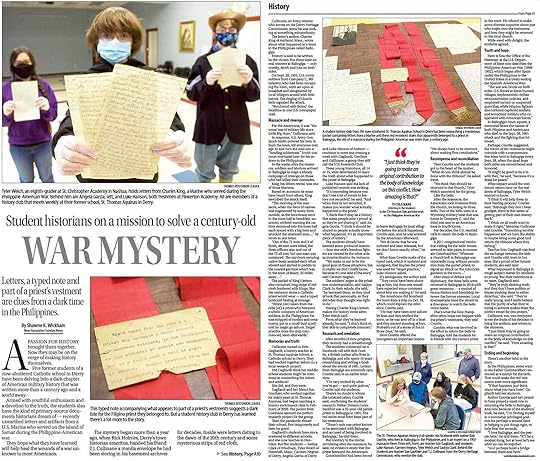
For years I have been digging into the history that too few Americans understand: I teach about Balangiga in one of my classes, I have blogged about it, written some more, and even been interviewed on podcasts. What happened there, if properly understood, could have warned us off tragedies at My Lai and Fallujah—maybe. Forgotten history helps no one, so I made this event the backstory of my character Ben Potter in Sugar Moon. (For even more of the history behind the novel, check out this list of posts.)
Research Tourism in the Philippines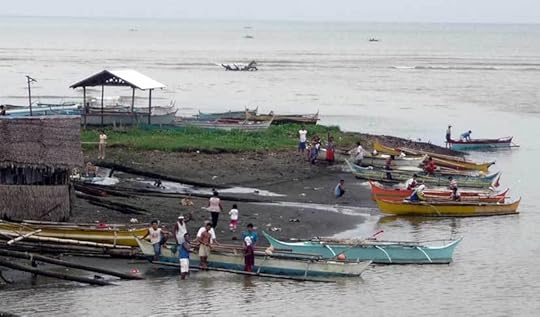 My photo of fishermen in Balangiga, at the junction of the Balangiga River and the Leyte Gulf. From there, it is not far until you are in the Pacific Ocean.
My photo of fishermen in Balangiga, at the junction of the Balangiga River and the Leyte Gulf. From there, it is not far until you are in the Pacific Ocean.I was so interested in investigating what happened at Balangiga that I dragged my husband down to Samar to see the town for ourselves. It was a quick trip, unfortunately, because torrential rains were causing mudslides, and we had to evacuate. (Note to self: Next time remember that different islands have different rainy seasons. Rookie mistake.) Because we could not get a flight out, we took a twenty-six-hour bus ride back on a urine-soaked back bench seat—the last two seats available, and with good reason. By the time we squeezed into a tric to get from the bus station to the airport parking lot, the eau de diesel of Manila bus traffic might as well have been the scent of daisies.
The image below is still one of my favorite pictures of the two of us from our life together in the Philippines. We moved back to the United States in 2011.

Imagine my surprise ten years later, when a few young historians uncovered new artifacts from Balangiga—in neighboring Derry, New Hampshire! These 8th- and 9th-grade students had become the caretakers of some letters, a leather strap, and a mysterious red sash—all artifacts that had been passed down from their original owner, Charles King, an American Marine from Amherst, Massachusetts. (The article said he was part of the Army, but his letter says otherwise.)

Because King had no children, he left the belongings to a nephew, who in turn gifted them to a man with a passion for history, T.J. Cullinane of the Derry Heritage Commission. Cullinane offered them to teachers Erin Gagliardi and Sue Gauthier. And Erin and Sue showed them to their history enrichment group, a non-credit activity for volunteer students at St. Thomas Aquinas School.
 The full set of artifacts, including a late picture of Charles King with his wife.
The full set of artifacts, including a late picture of Charles King with his wife.The pandemic shut down their school, but they kept working on the project—all the more earnestly because they did not have the typical distractions of busy school life and classes. They transcribed the letters and started to learn about a campaign of retribution that troubled them.

Charles King believed he was serving justice upon the people of Balangiga and southern Samar, punishing them for their uprising that killed 48 of 77 soldiers in Company C, Ninth Infantry. The story that King and everyone else was told was simple: the attack was unprovoked treachery on the part of ungrateful Filipinos led by General Vincente Lukban of the Philippine Revolutionary Army. It was not until Bob Couttie and Professor Rolando O. Borrinaga dug deeper that the truth was revealed.
Lukban’s lieutenants may have approved of the idea of the attack, but the real masterminds were the leaders of the town itself. They had just been pushed too far. Captain Connell, commanding officer of Company C, had upset the people with heavy-handed tactics, forced labor, and nightly imprisonment of the men in inhumane conditions.
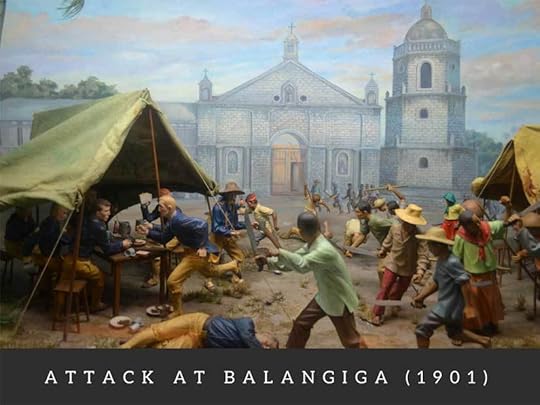 One of many wonderful dioramas designed by the Ayala Museum and now viewable through the Google Cultural Institute.
One of many wonderful dioramas designed by the Ayala Museum and now viewable through the Google Cultural Institute.The town struck back. They sent the women away and drew in extra men from the surrounding villages. On Saturday, September 28, 1901, while many in the garrison were nursing hangovers from the previous night’s festival, the town attacked them at breakfast. It was a gruesome scene. The battle lasted a few hours until a handful of American survivors fled the town, eventually making it to a neighboring garrison—barely.
The Howling WildernessThe very next day, an American expedition set out to burn Balangiga to the ground and, later, much of the rest of southern Samar. Their commanding officer, General Jacob H. Smith of the Sixth Separate Brigade, told them: “I want no prisoners. I wish you to kill and burn, the more you kill and burn the better it will please me.” He wanted his men to make Samar a “howling wilderness.” It was a disproportionate response that caused extensive and unnecessary suffering throughout the island.
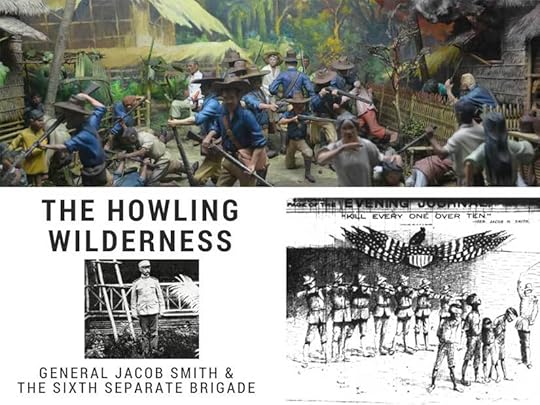 Another of the many wonderful dioramas designed by the Ayala Museum and now viewable through the Google Cultural Institute. Also included are a photo of General “Hell-roaring Jake” Smith and the New York Journal editorial cartoon of his order, both in the public domain and found on Wikipedia.
Another of the many wonderful dioramas designed by the Ayala Museum and now viewable through the Google Cultural Institute. Also included are a photo of General “Hell-roaring Jake” Smith and the New York Journal editorial cartoon of his order, both in the public domain and found on Wikipedia.The Sixth Separate Brigade also went out looking for the priest of Balangiga, whom they believed had taken part in the planning and execution of the attack. It seems that Charles King was part of the team who found him.
Guimbaolibot’s stoleThe most important artifact left to the Derry students was the “ribon [sic] taken from the robe” of a priest who “betrayed a whole company of American soldiers.” The students would later find out that the priest, Father Donato Guimbaolibot, did not betray the Americans. In fact, Padre Guimbaolibot left town in order to remove his sanction from the events that would take place. He did not warn the Americans, true, but since the Americans were imprisoning all of the town’s men, about 150 people, in two tents built for sixteen, maybe the priest just wanted to get the heck out of there and find help.

Father Christopher Gaffrey, the Franciscan associate pastor at St. Thomas Aquinas, helped the students examine the ribbon—a stole, he informed them, which meant it was a sacred priestly vestment. When he looked at the loop, he noticed the original dye was likely a dark purple, the kind used for the sacrament of confession.

The students wanted to know more, and they got in touch with author and historian Bob Couttie, author of Hang the Dogs: The True Tragic Story of the Balangiga Massacre. Bob’s book was one of the key sources that I used for Sugar Moon. Bob helped them understand what had really happened—especially to the maligned priest who later was captured, tortured, and traumatized. Charles King likely played a part in Guimbaolibot’s ordeal because it was he who brought the sash home as a war souvenir.
Bob asked the students what they planned to do with the stole. The students answered as one: “Send it back where it belongs.” Matching the recent return of the bells, a public gesture, this is an amazing private gesture. Young they may be, but these students knew the right thing to do, without adult guidance. Their teachers support them, but they did not suggest this course.
Small World syndrome Most of the Sugar Sun series takes place in the Visayan Islands in the central and southern Philippines.
Most of the Sugar Sun series takes place in the Visayan Islands in the central and southern Philippines.I knew none of what was happening just forty minutes down the road from my home. When I read the article, I could not believe what I had missed. But this week I was able to meet the students myself, see the artifacts, and answer more of their questions. I even told them the bus trip story. They do not need me, but I was at least able to help them identify a few towns and tell them a bit more about the wider context of this battle and what happened afterward. They asked wonderful questions about religious conflicts in the islands, about the diseases that worsened the civilian toll of the war, as well as current US-Philippine relations. Their curiosity was a credit to them, as if the whole enterprise has not already been.
 Photo courtesy of Erin Gagliardi.
Photo courtesy of Erin Gagliardi.
May 8, 2021
Beauty and the Priest
The first draft is nearly done, but what’s it hurt to make a nice promo image in anticipation?

He is loved by everyone and no one.
She is a woman of science not sacrifice.
Neither should be the other half of the whole,
But love is a grace not a choice.
March 13, 2021
New Podcast on Balangiga!
The Balangiga incident/massacre/battle was a shocking twist in a war that seemed to be winding down. To many Americans and Filipinos, though, the conflict was just beginning…
Novelist Jennifer Hallock shares her research on Balangiga, and her experience teaching Philippines History in a US classroom. She explains how the surprise attack on US troops in Samar was the culmination of years of brutal warfare from 1898 to 1902. Local men disguised themselves covertly and snuck around town before striking Americans at breakfast. But while villagers may have repelled American soldiers temporarily, the aftermath of Balangiga would last for a very long time. On today’s episode we’re going to use events from a short battle to understand the effects of a much wider war…
Link to podcast: http://turnofthecentury.buzzsprout.com/1406677/6587164-balangiga-incident-w-jennifer-hallock
I chatted with Joe Hawthorne about the attack at Balangiga in the Philippine-American War and how the American counteroffensive and the 1902 Senate hearings on “marked severities” predicted future outcries over My Lai and Fallujah. We redid parts of the interview, and because of the way it was edited, I introduce General Smith twice. His orders are shocking enough to revisit, though, so it works.
Learn why this was the most important war no one told you about. (This attack is the thematic background to my novel Sugar Moon, which is set in Balangiga itself, through flashbacks, and then in Samar during the subsequent blowback.) I also give credit to a few of my key sources, including Dr. Rolando O. Borrinaga and Bob Couttie. Thanks to Joe for this opportunity to dig deeper into the history of the Philippine-American War and why I write what I write.

One of the 10 Best Historical Romances with Sports!
I’m so thrilled that Sugar Moon made this list from Joanna Shupe and Frolic. There are some amazing books on that list, and it is an honor to be included. The ones I’ve not yet read are now tops of my TBR.
 Thrilled to keep this company on Frolic’s 10 Best Historical Romances with Sports.
Thrilled to keep this company on Frolic’s 10 Best Historical Romances with Sports.The list celebrates Shupe’s latest release, The Heiress Hunt, featuring a tennis-playing heroine based on “Suzanne Lenglen, a Frenchwoman who dominated in the early 20th-century with her aggressive style of play,” as Shupe writes. “The unconventional Lenglen pioneered “sportswear” attire for women, drank cognac during her matches, and was unapologetic about her superior skills on the court. (Seriously, where is this woman’s biopic??!)” I’m game!
 Get your copy of The Heiress Hunt> at your favorite vendor. Links here on Joanna Shupe’s website.
Get your copy of The Heiress Hunt> at your favorite vendor. Links here on Joanna Shupe’s website.Shupe wrote why she had chosen each book for the list. Here’s what she said about Sugar Moon:
Set in the Philippines in the early 1900s, this richly layered romance is filled with vivid details of a location not often found in historical romance—including a historical baseball game! The hero, Ben, is suffering from what we now know as PTSD from the war, and he struggles with his self-worth. When he meets the fiercely independent schoolteacher Allegra, their chemistry turns this into a heart-tugging and wonderful journey of redemption.

Yes, that’s a proposal scene! There are two baseball scenes, both related to courtship, in Sugar Moon because Ben is a dedicated player—and fortunately his sister has already brought the game to the hacienda. Everyone comes out to see if Ben can win his lady’s hand with runs. Read more excerpts from the novel here, or order it on Amazon today!

March 11, 2021
Tempting Hymn is Free!
Jonas Vanderburg needs Rosa Ramos’s help to rebuild both his health and his life. But Rosa is scared to pin her future on the promises of yet another American. Leaving hospital together is not the biggest challenge for these two people from different faiths, countries, and generations: the missionary mafia that controls colonial Philippine society may never bless their union.

This is a steamy, historical, and cross-cultural marriage-of-convenience novella. If you like strong-but-silent blue-collar heroes and clever nurse heroines, this is the book for you. In a pandemic year, content guidance is more important to you than ever. A full list—including epidemic disease (cholera)—can be found here.
Named a Desert Isle Keeper from All About Romance: “If you like underrepresented settings, social class conflict, intercultural romance, working-class characters, or just damn good historicals, the Sugar Sun series is one to get into. I’m certainly developing a sweet tooth!”
 More praise for Tempting Hymn, a novella in the Sugar Sun series:
More praise for Tempting Hymn, a novella in the Sugar Sun series:“I told myself I would go to bed early, but then I opened Tempting Hymn.” (Amazon Reviewer)
“Tempting Hymn manages to give adequate breathing room to the harsh historical realities of American colonial rule in the Philippines, while delivering a romance that is sweet, realistic and—above all—emotional. . . . Hallock doesn’t pull any punches in Tempting Hymn, with either the romance or the historical detail. She does her setting and her characters justice, delivering a story that is raw and unflinching, but never too dark, because it has an engaging and touching romance at its core. [And] all the sex scenes here are insanely hot, just like in Under a Sugar Sun.” (Dani St. Clair, Romancing the Social Sciences)
“This novella does a hell of a lot of work between the lines. It’s actually breathtaking.” (Kat at BookThingo, posted on Twitter)
“The pairing here is American man/Filipino woman and that is a tricky, sensitive trope…but it’s handled with deft and care. And dignity.” (Mina V. Esguerra, author of Iris After the Incident, reviewed on Facebook)
“…the first love scene between Jonas and Rosa is a master class.” (Bianca Mori, author of the Takedown trilogy, reviewed on Goodreads)
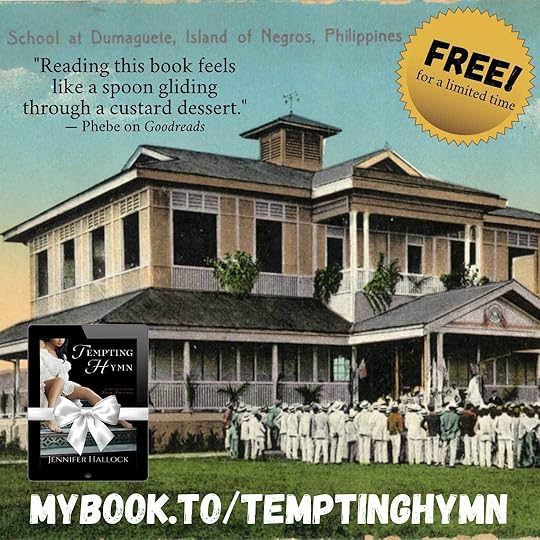
Sugar Sun Series Extras
- Jennifer Hallock's profile
- 38 followers


